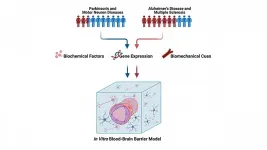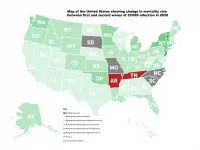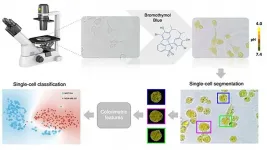(Press-News.org) Like a well-trained soldier, a white blood cell uses specialized abilities to identify and ultimately destroy dangerous intruders, including creating a protrusion to effectively reach out, lock-on, probe, and possibly attack its prey. Researchers reporting March 16 in Biophysical Journal show in detail that these cells take seconds to morph into these highly rigid and viscous defensive units.
Senior author Julien Husson (@_julienhusson), a biophysicist at École Polytechnique near Paris, and collaborators showed previously that certain white blood cells, called T cells, can push and pull perceived threats via specialized connections. To exert such forces, a cell must reorganize its internal structure, making itself more rigid. In the current study, Husson's team devised a micropipette rheometer to measure the rigidity, along with the viscosity, of a white blood cell during its transformation. The researchers' goal was to quantify the physical changes that arise in a white blood cell as it pushes or pulls on a foreign body--in this case, a bead coated with chemicals to attract the cell.
"We knew that when forming and using its protrusion, the cell was strongly reorganizing its cytoskeleton and that this cytoskeleton is a big player in giving a cell its mechanical properties," says Husson. "So, I believed there should be some signature mechanical trace."
Stiffness is a measure of how much a material deforms when under a certain amount of pressure, whereas viscosity refers to how fast the material deforms under this pressure. Therefore, to simultaneously measure these properties of a white blood cell while instigating the cell's immune response, the team needed an experimental setup that could somehow both maintain and vary the force on the cell while also causing it to respond as if it come upon a threat.
The researchers' solution was to apply a force that carefully oscillated around a constant, average value. The cell's stiffness was calculated from the tiny deformation induced by the oscillations, and the viscosity was calculated from the delay between an oscillation and resulting deformation. At the same time, the object applying the force was a bead coated with antibodies, which caused the cell to activate, change shape, and latch onto the bead.
"Despite expecting some mechanical changes, what we found was surprisingly dramatic," says Husson. The team looked at three types of white blood cells and discovered that in all cases, "the cells' stiffnesses and viscosities begin changing within seconds of coming into contact with the beads and increase up to ten times within minutes."
"Intriguingly," Husson says, "the mechanical changes begin even before any shape changes," evoking the question of whether these significant changes to white blood cells' mechanical properties are simply consequences of other functions or have their own utility.
The answer to this question could lie in another result of the study: Husson and colleagues found that a cell's stiffness and viscosity change together, at a fixed ratio that is unique to the cell type, like a mechanical fingerprint. "It was really exciting to know that there was this kind of universality," he says.
Altogether, the paper's results suggest an underlying physical mechanism that could apply broadly across cell types and lead to new models, theories, and ultimately a better understanding and control of our cells, in our immune system and beyond.
INFORMATION:
This work was primarily funded by the French National Research Agency, CNRS, École Polytechnique, and the AXA Research Fund.
Biophysical Journal, Zak et al.: "Rapid viscoelastic changes are a hallmark of early leukocyte activation" https://www.cell.com/biophysj/fulltext/S0006-3495(21)00200-9
Biophysical Journal (@BiophysJ), published by Cell Press for the Biophysical Society, is a bimonthly journal that publishes original research and reviews on the most important developments in modern biophysics--a broad and rapidly advancing field encompassing the study of biological structures and focusing on mechanisms at the molecular, cellular, and systems levels through the concepts and methods of physics, chemistry, mathematics, engineering, and computational science. Visit: http://www.cell.com/biophysj/home. To receive Cell Press media alerts, contact press@cell.com.
WASHINGTON, March 16, 2021 -- Men and women are impacted differently by brain diseases, like Alzheimer's disease and Parkinson's disease. Researchers are urging their colleagues to remember those differences when researching treatments and cures.
In APL Bioengineering, by AIP Publishing, University of Maryland scientists highlight a growing body of research suggesting sex differences play roles in how patients respond to brain diseases, as well as multiple sclerosis, motor neuron disease, and other brain ailments.
That is progress from just a few years ago, said Alisa Morss ...
Stem-cell-derived organoids that swell up with tears could shed light on the biology of crying and dry-eye disease, suggests a study publishing March 16 in the journal Cell Stem Cell. Although regenerative therapies using human tear-gland organoids will not be possible anytime soon, these researchers have demonstrated that the organoids can engraft, integrate, and produce mature tear products upon transplantation into mouse tear glands.
"We hope that scientists will use our model to identify new treatment options for patients with tear-gland disorders by either testing new drugs on a patient's organoids or expanding healthy cells and, one day, using them for transplantation," says senior study author Hans Clevers (@HansClevers) of the Hubrecht Institute.
The ...
Wealthier northeastern US states and Western European countries tended to have significantly lower mortality rates during second-wave COVID-19 infections, new research from the University of Sydney and Tsinghua University has shown. However, the pattern was not as general as expected, with notable exceptions to this trend in Sweden and Germany.
Researchers say mortality change could have several explanations:
European first-wave case counts were underestimated;
First-wave deaths disproportionately affected the elderly;
Second-wave infections tended to affect younger people;
With some ...
WASHINGTON, March 16, 2021 -- Cancerous cells exhibit several key differences from healthy cells that help identify them as dangerous. For instance, the pH -- the level of acidity -- within a cancerous cell is not the same as the pH within a healthy cell.
Researchers from the National University of Singapore developed a method of using machine learning to determine whether a single cell is cancerous by detecting its pH. They describe their work in the journal APL Bioengineering, from AIP Publishing.
"The ability to identify single cells has acquired a paramount importance in the field of precision and personalized medicine," ...
What The Study Did: The findings of this study suggest that, based on a sample from an otherwise healthy population, the overall number of SARS-CoV-2 infections in the U.S. may be substantially higher than estimates based on public health case reporting.
Authors: Robert L. Stout, Ph.D., of Clinical Reference Laboratory Inc. in Lenexa, Kansas, is the corresponding author.
To access the embargoed study: Visit our For The Media website at this link https://media.jamanetwork.com/
(doi:10.1001/jamanetworkopen.2021.1552)
Editor's Note: The article includes conflict of interest and funding/support disclosures. Please see the article for additional information, including other authors, author contributions and affiliations, ...
What The Study Did: Researchers examined nursing homes in communities with the highest COVID-19 prevalence to identify characteristics associated with resident infection rates.
Authors: Hye-Young Jung, Ph.D., of Weill Cornell Medical College in New York, is the corresponding author.
To access the embargoed study: Visit our For The Media website at this link https://media.jamanetwork.com/
(doi:10.1001/jamanetworkopen.2021.1555)
Editor's Note: The article includes funding/support disclosures. Please see the article for additional information, including ...
The first systematic study of its kind describes how human viruses including SARS-CoV-2 are better adapted to infecting certain types of tissues based on their ability to hijack cellular machinery and protein synthesis.
Carried out by researchers at the Centre for Genomic Regulation (CRG), the findings could help the design of more effective antiviral treatments, gene therapies and vaccines. The study is published today in the journal Cell Reports.
Living organisms make proteins inside their cells. Each protein consists of single units of amino acids which are stitched together according to instructions encoded within DNA. The basic units of these instructions are known as a codons, each of which corresponds ...
When scientists at the Institute of Science and Technology (IST) Austria looked at developing zebrafish embryos, they observed an abrupt and dramatic change: within just a few minutes, the solid-like embryonic tissue becomes fluid-like. What could cause this change and, what is its role in the further development of the embryo? In a multidisciplinary study published in the journal Cell, they found answers that could change how we look at key processes in development and disease, such as tumor metastasis.
To learn more about how a tiny bunch of cells develops into complex systems ...
CAMBRIDGE, MA -- In the past few years, several medications have been found to be contaminated with NDMA, a probable carcinogen. This chemical, which has also been found at Superfund sites and in some cases has spread to drinking water supplies, causes DNA damage that can lead to cancer.
MIT researchers have now discovered a mechanism that helps explain whether this damage will lead to cancer in mice: The key is the way cellular DNA repair systems respond. The team found that too little activity of one enzyme necessary for DNA repair leads to much higher cancer rates, while too much activity can produce tissue damage, especially in the liver, which can be fatal.
Activity ...
Several oceans' worth of ancient water may reside in minerals buried below Mars' surface, report researchers. The new study, based on observational data and modeling, shows that much of the red planet's initial water - up to 99% - was lost to irreversible crustal hydration, not escape to space. The findings help resolve the apparent contradictions between predicted atmospheric loss rates, the deuterium to hydrogen ratio (D/H) of present-day Mars and the geological estimates of how much water once covered the Martian surface. Ancient Mars was a wet planet - dry riverbeds and relic shorelines record a time when vast volumes of liquid water flowed across the surface. Today, ...



